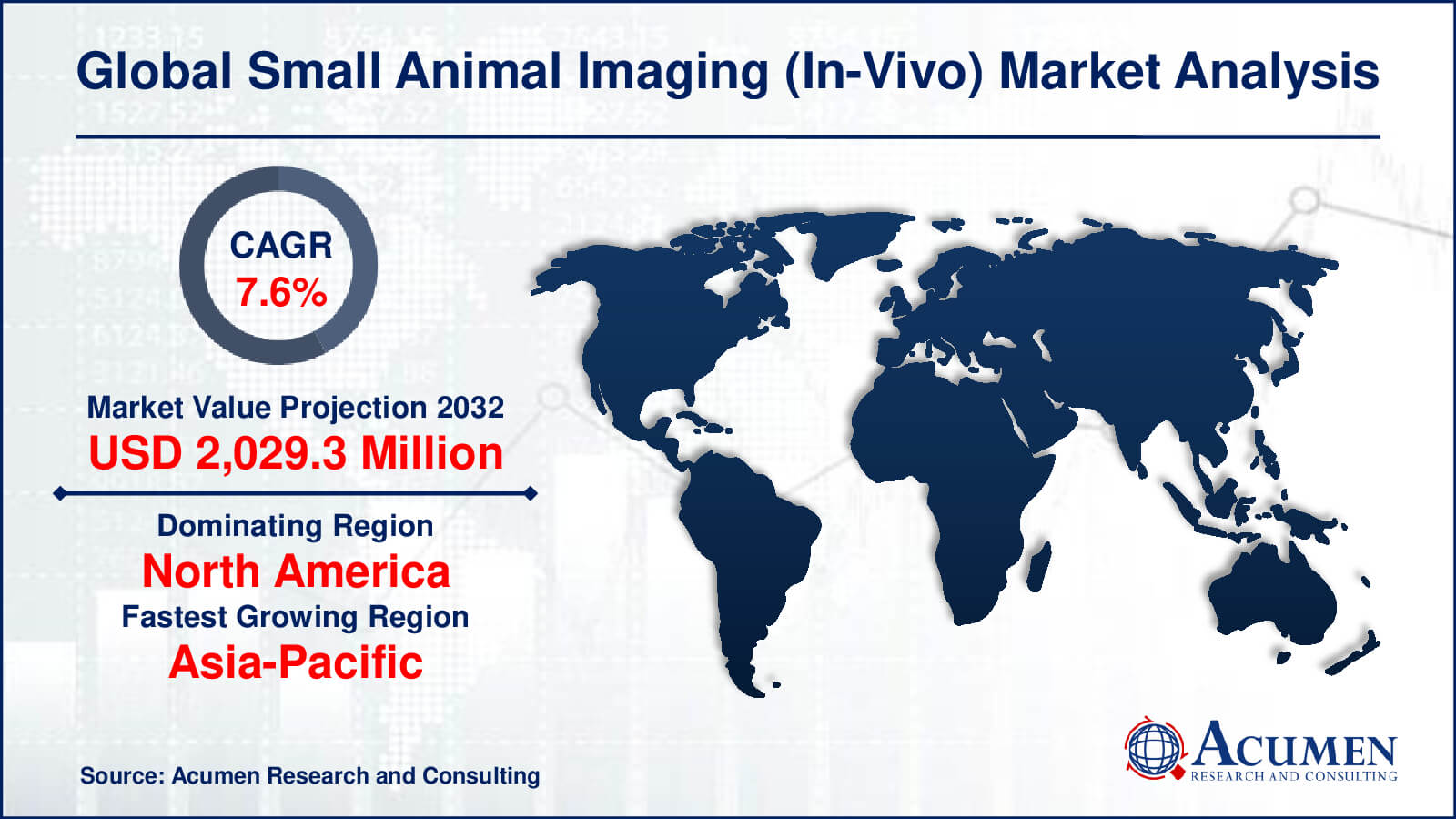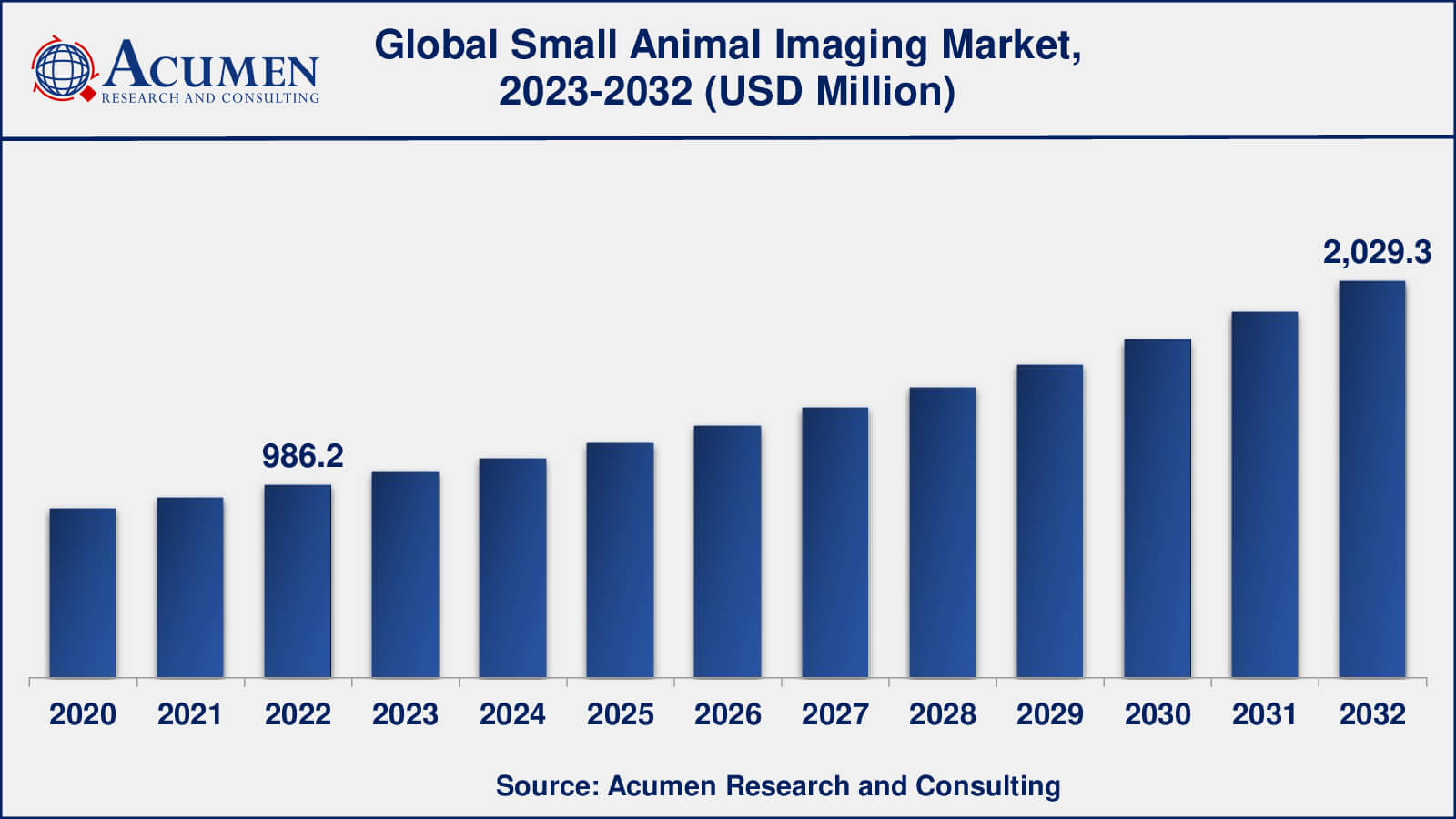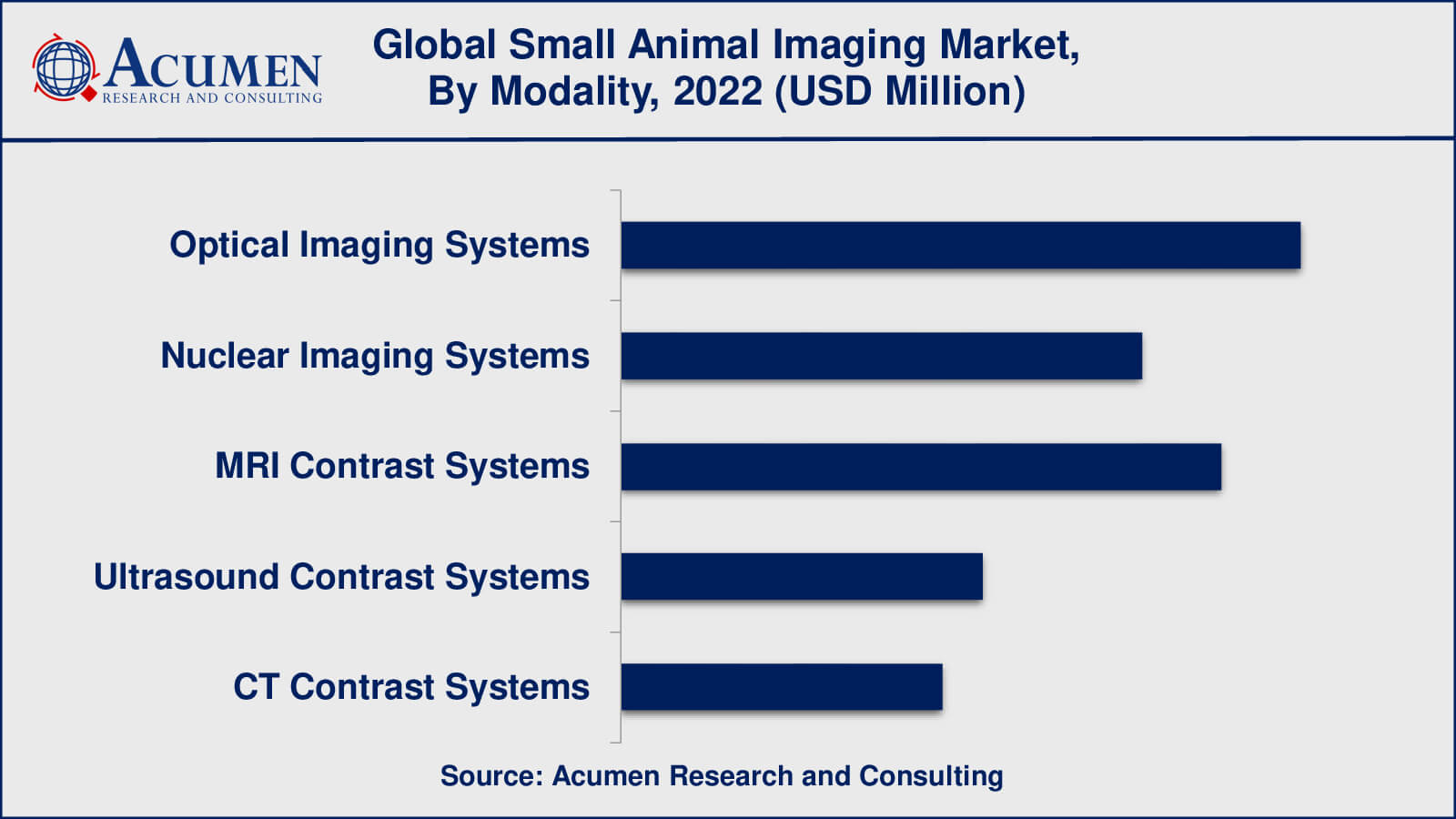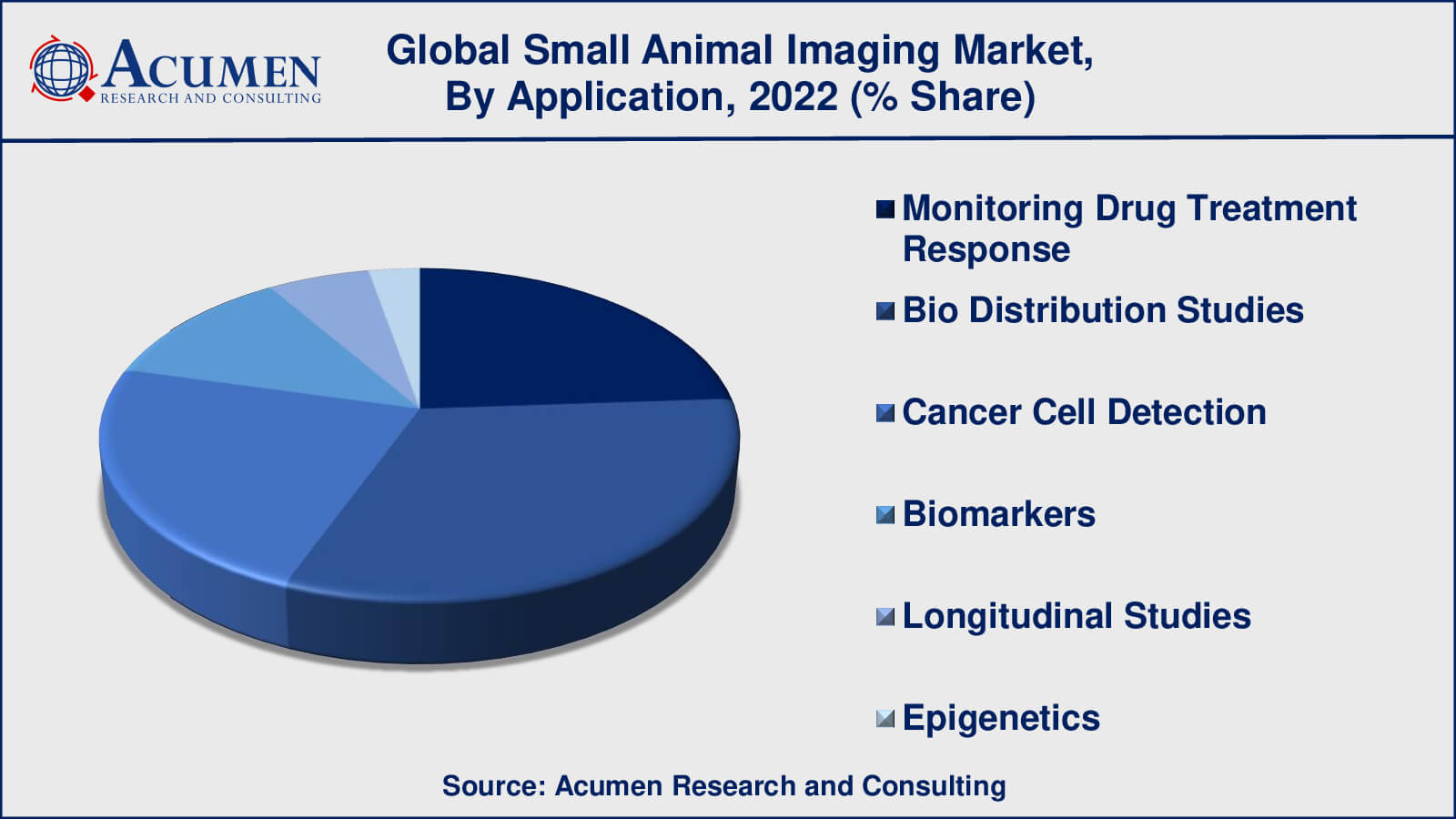February 2025
Small Animal Imaging Market Size accounted for USD 986.2 Million in 2022 and is estimated to achieve a market size of USD 2,029.3 Million by 2032 growing at a CAGR of 7.6% from 2023 to 2032.
The Global Small Animal Imaging Market Size accounted for USD 986.2 Million in 2022 and is estimated to achieve a market size of USD 2,029.3 Million by 2032 growing at a CAGR of 7.6% from 2023 to 2032.
Small Animal Imaging Market Highlights

Small animal imaging is the non-invasive imaging of small laboratory animals, usually mice and rats, for the investigation of biological processes, the progression of disease, and the effectiveness of therapeutic interventions. Microcomputed tomography (micro-CT), magnetic resonance imaging (MRI), positron emission tomography (PET), single-photon emission computed tomography (SPECT), and optical imaging are the imaging modalities that are most frequently employed for small animal imaging.
Imaging of small animals is essential for a number of reasons. First off, it enables non-invasive studies of the effects of medications and other therapeutic interventions on living animals, which is essential for creating novel disease therapies. Small animal imaging also makes it possible to monitor the development of diseases and research the underlying biological pathways in real-time, giving important insights into the onset and course of illnesses.
Small animal imaging is in demand because it offers a potent tool for preclinical research, allowing scientists to examine disease models and therapeutic treatments in vivo before going on to human trials. This may aid in accelerating the process of developing new drugs and cutting down on the price of conducting clinical trials. Small animal imaging also contributes to the development of personalized medicine by enabling the recognition of individual variations in disease progression and therapeutic response.

Global Small Animal Imaging Market Dynamics
Market Drivers
Market Restraints
Market Opportunities
Small Animal Imaging Market Report Coverage
| Market | Small Animal Imaging Market |
| Small Animal Imaging Market Size 2022 | USD 986.2 Million |
| Small Animal Imaging Market Forecast 2032 | USD 2,029.3 Million |
| Small Animal Imaging Market CAGR During 2023 - 2032 | 7.6% |
| Small Animal Imaging Market Analysis Period | 2020 - 2032 |
| Small Animal Imaging Market Base Year | 2022 |
| Small Animal Imaging Market Forecast Data | 2023 - 2032 |
| Segments Covered | By Modality, By Application, By End-User, And By Geography |
| Regional Scope | North America, Europe, Asia Pacific, Latin America, and Middle East & Africa |
| Key Companies Profiled | Bruker Corporation, PerkinElmer, Inc., Mediso Medical Imaging Systems, GE Healthcare, Siemens Healthineers, Aspect Imaging Ltd., MILabs B.V., MR Solutions Ltd., Scanco Medical AG, Fujifilm Holdings Corporation, LI-COR Biosciences, Thermo Fisher Scientific Inc., TriFoil Imaging, Miltenyi Biotec, and Spectral Instruments Imaging. |
| Report Coverage |
Market Trends, Drivers, Restraints, Competitive Analysis, Player Profiling, Covid-19 Analysis, Regulation Analysis |
Small Animal Imaging Market Insights
The small animal imaging market is driven by several key dynamics that shape its growth and development. One of the primary drivers is the increasing demand for preclinical research. The rising need for preclinical research is one of the main forces. The research of disease causes, the assessment of therapeutic treatments, and a better comprehension of biological processes in live creatures are all made possible by small animal imaging. The desire for more efficient and affordable drug development procedures serves to increase this demand.
The small animal imaging industry is being driven ahead by technological developments. The capabilities and uses of imaging tiny animals are expanding as a result of ongoing developments in imaging modalities, such as increased resolution, sensitivity, and specificity. These developments make it possible for researchers to collect more exact and thorough data, improving disease models, providing greater understanding of therapy responses, and allowing for a more accurate assessment of treatment efficacy.
Another factor propelling the small animal imaging market is the increased occurrence of illnesses. In-depth study and inquiry are needed for conditions including cancer, neurological problems, and cardiovascular ailments. Small animal imaging is an important non-invasive method for tracking the development of diseases, finding biomarkers, and evaluating therapy results. This supports the creation of efficient treatments and personalized medical strategies.
The development of the small animal imaging market is considerably aided by funding from the pharmaceutical sector. Small animal imaging in preclinical investigations is valuable because it enables drug candidates to be assessed in vivo before moving on to human clinical trials, which is something pharmaceutical corporations are aware of. Pharmaceutical firms may optimize the medication development process and detect possible dangers by using small animal imaging methods, which will eventually save costs and increase success rates.
Government initiatives and financing can influence the dynamics of the small animal imaging industry. Governments and academic institutions contribute funds to foster interdisciplinary research and the creation of cutting-edge imaging technology. With the help of these investments, academic, industrial, and healthcare organizations may work together to innovate, progress technologies, and expand their markets.
Although there are major market drivers for tiny animals, there are also barriers and difficulties to take into account. The high cost of small animal imaging systems and related technologies may make them inaccessible to universities and smaller research labs with tighter resources. Conducting small animal imaging research can be difficult due to ethical issues with animal care and legal restrictions. Additionally, there can be constraints in applying findings from studies on small animals to patients in humans, necessitating additional validation and clinical trials.
Small Animal Imaging (In-Vivo) Market Segmentation
The worldwide market for small animal imaging is split based on modality, application, end-user, and geography.
Small Animal Imaging (In-Vivo) Modality

According to small animal imaging industry data, optical imaging systems such as bioluminescence imaging and fluorescence imaging have also played an important role in the small animal imaging market. Researchers may use optical imaging to study molecular and cellular activities in real time, yielding vital insights into disease causes and therapy responses. Its great spatial resolution and molecular specificity make it ideal for researching gene expression, protein-protein interactions, and cellular processes in tiny animals.
Small animal imaging has made considerable use of nuclear imaging techniques such as positron emission tomography (PET) and single-photon emission computed tomography (SPECT). These techniques have high sensitivity, allowing researchers to see and quantify chemical processes and biological activities in real time. Nuclear imaging is very useful in small animal models for examining metabolism, receptor binding, and gene expression.
While nuclear imaging and optical imaging have traditionally dominated, additional modalities like as magnetic resonance imaging (MRI), computed tomography (CT), and ultrasound are now routinely employed in small animal imaging. Each modality has advantages and disadvantages. MRI gives superior anatomical and functional information, CT provides high-resolution 3D imaging, and ultrasound enables for real-time imaging with exceptional tissue penetration.
Small Animal Imaging (In-Vivo) Applications

As per the small animal imaging market forecast, cancer research is expeted to grow with significant CAGR from 2023 to 2032. Cancer research and understanding tumor development and progression are critical areas of study in both preclinical and translational research. Small animal imaging modalities are widely employed to detect and monitor cancer cells in animal models, enabling researchers to assess tumor growth, metastasis, and response to various treatments.
Small animal imaging techniques, such as optical imaging, nuclear imaging (PET/SPECT), and magnetic resonance imaging (MRI), have been extensively utilized for cancer cell detection in preclinical studies. Optical imaging allows the visualization of specific cancer markers using fluorescence or bioluminescence probes. Nuclear imaging techniques, such as PET, enable the detection of radiolabeled tracers that accumulate in tumor cells, providing insights into tumor metabolism and receptor expression. MRI provides anatomical and functional information, allowing the identification and characterization of tumor lesions.
Cancer cell detection using small animal imaging is essential for understanding tumor biology, evaluating novel therapeutic approaches, and assessing treatment responses. It enables researchers to track tumor growth, monitor metastasis, evaluate drug efficacy, and identify potential biomarkers associated with cancer progression. This information is crucial for developing targeted therapies, assessing treatment regimens, and advancing our understanding of cancer biology
Small Animal Imaging (In-Vivo) End-Users
Biotechnology and pharmaceutical industries have long controlled the small animal imaging industry as the key end-users. These firms make substantial use of small animal imaging technology for preclinical research and medication development. Before moving on to human clinical trials, they can use small animal imaging to assess the effectiveness, safety, and pharmacokinetics of potential drug candidates, explore disease processes, and optimise treatment regimens. The capacity to see and measure biological processes in live animals non-invasively is critical in their drug research and development pipeline.
End-users in the small animal imaging industry include academic and research institutions. These organisations undertake fundamental research, study illness models, and test new treatment methods. Small animal imaging provides these researchers with significant tools for studying illness development, evaluating therapy responses, and gaining insights into underlying biological systems. Academic and research institutions help to further our understanding of illnesses and the development of novel diagnostic and treatment techniques.
While biotechnology and pharmaceutical businesses, as well as academic/research organisations, are the key end-users, the small animal imaging market might also include other entities. Contract research organisations (CROs) that provide preclinical imaging services, government bodies that fund and support research programmes, and veterinary clinics or hospitals that use small animal imaging for diagnostic purposes in veterinary medicine are examples of these organisations.
Small Animal Imaging In-Vivo Market Regional Outlook
North America
Europe
Asia-Pacific
Latin America
The Middle East & Africa
Small Animal Imaging Market Regional Analysis
North America has been a major market for small animal imaging due to the existence of well-established biotechnology and pharmaceutical businesses, superior research infrastructure, and large investments in research and development. The US, in particular, has a large market presence and considerable demand for preclinical research and drug development.
Europe is another important market for small animal imaging. Countries with a strong research base and modern healthcare infrastructure, such as Germany, the United Kingdom, and France, are driving market expansion. Academic institutions, research centers, and cooperation between academia and business all contribute to the market's growth.
The Asia-Pacific region's small animal imaging industry is expanding rapidly. Countries such as China, Japan, and India are investing considerably in biomedical research, and preclinical investigations are on the rise. Increasing government financing, increasing pharmaceutical and biotechnology industries, and rising awareness of personalized medicine are important drivers driving this region's industry.
Small Animal Imaging Market Players
Some of the top small animal imaging companies offered in our report include Bruker Corporation, PerkinElmer, Inc., Mediso Medical Imaging Systems, GE Healthcare, Siemens Healthineers, Aspect Imaging Ltd., MILabs B.V., MR Solutions Ltd., Scanco Medical AG, Fujifilm Holdings Corporation, LI-COR Biosciences, Thermo Fisher Scientific Inc., TriFoil Imaging, Miltenyi Biotec, and Spectral Instruments Imaging.
Mediso debuted the Nucline Si PET/MRI system, which combines PET and MRI technologies for small animal imaging. The method allows researchers to link molecular and structural information in preclinical investigations by providing high-resolution anatomical and functional imaging.
The VECTor5CT imaging system from GE Healthcare combines X-ray CT and PET imaging modalities. The technology improves the resolution and sensitivity of multimodal preclinical imaging, allowing researchers to acquire precise anatomical and functional data at the same time.
Looking for discounts, bulk pricing, or custom solutions? Contact us today at sales@acumenresearchandconsulting.com
February 2025
September 2022
March 2021
June 2022